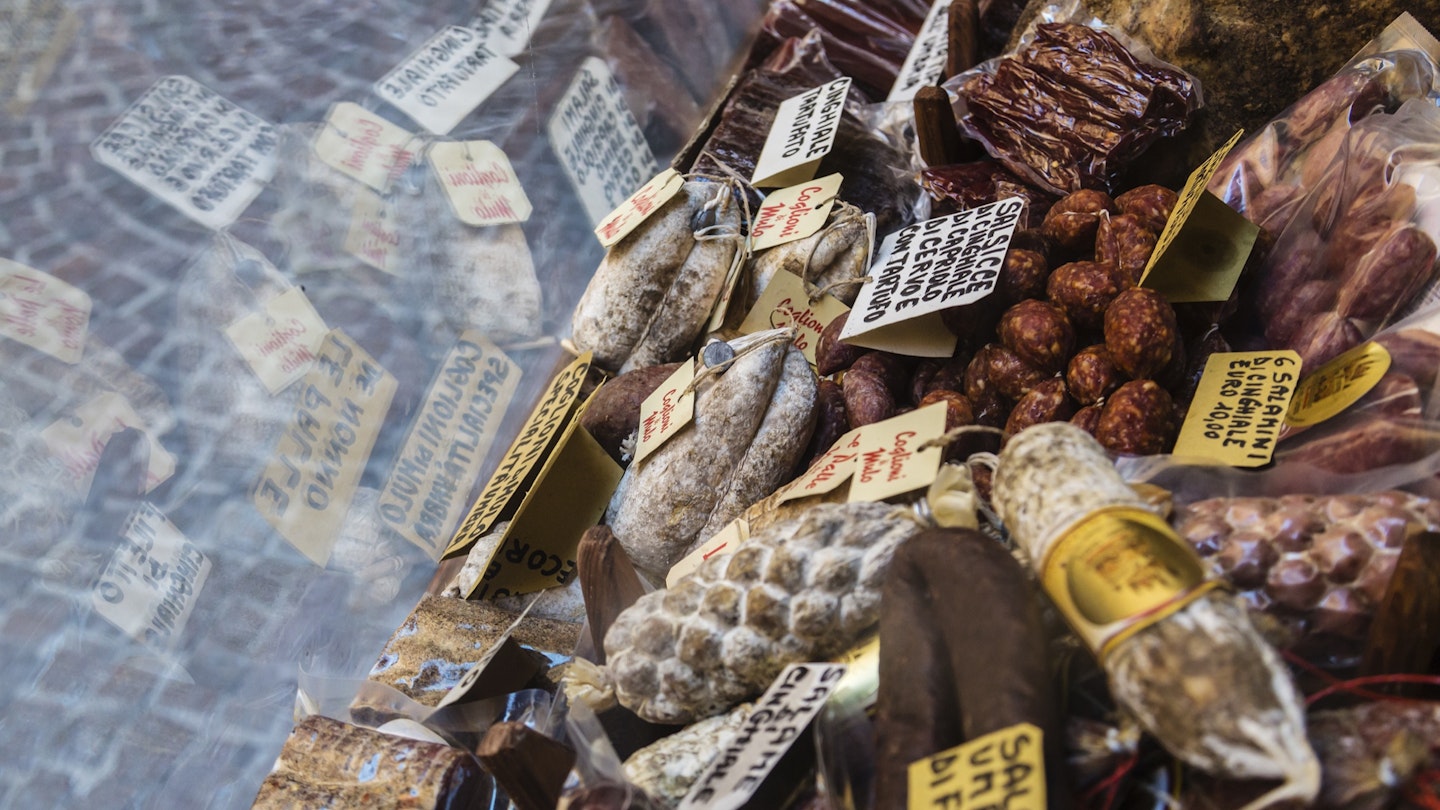Culinary Delights of Umbria, Italy
Located in the heart of central Italy, Umbria is a region rich with dense forests, rolling hills, historic towns, and some of the best food the country has to offer.
The unique terroir has given rise to specialties like cured meats, earthy truffles, flavorful olive oils, and full-bodied wines—delicacies to delight the taste buds of travelers. Here’s our guide to the best bites the region has to offer:

Smoked and Roasted
Start your visit in the southeastern corner of Umbria in the historic walled city of Norcia, found within Monti Sibillini National Park. For centuries, Norcia’s norcini, or pork butchers, have produced top-quality cured meats, salumi, and sausages. The local pigs, with a diet rich in acorns and local herbs, add distinct flavor to the meat.
Additionally, the land around Norcia is home to wild boar, which features prominently in the local cuisine. When in Norcia, seek out a norcineria, specialty butchers renowned for their pork products. Dishes to try include porchetta, a roasted pork dish, and pasta alla norcina, pasta mixed with a rich sausage and cream sauce.

Lentils and Truffles
From Norcia, head to the nearby plains of Castelluccio, located in the Apennine Mountains, famous for its lentils. These small, tender lentils are cultivated at nearly 5000 feet (1500m) and have been awarded the IGP designation, indicating a protected geographical origin. The breathtaking blooms of wildflowers around the lentil fields in June create a stunning backdrop, with harvesting occurring in July. Enjoy these lentils in rich, nutty soups often flavored with local pork.
Umbria’s fertile forests also produce abundant truffles throughout the year. Scorzone truffles can be found in the summer months, while the rarer white truffles are primarily discovered in winter, mainly around Città di Castello. Visitors can join expert truffle hunters and their dogs for a unique experience. Truffles, often shaved over pasta or incorporated into risottos and sauces, are widely celebrated in Umbria’s culinary scenes.

A Cornucopia of Produce
Departing the truffle-rich regions, head north to the hills between Spoleto and Assisi. This area is recognized as Umbria’s main olive oil-producing region. The production of olive oil in Umbria has ancient roots dating back to the Etruscans and Romans, with Trevi being the olive oil capital of the region.
Trevi is located along the Sentiero degli Ulivi, or olive trail, a 45-mile (75km) path that winds through olive groves while linking the major towns of the region. Visitors can explore the Museo della Civiltà dell’Ulivo, a museum dedicated to the history of olive oil production. Nearby, one can visit an olive oil mill (frantoio) to witness the production process (in season) and sample the local oils.
The region also features unique vegetables such as the black celery, sedano nero di Trevi, known for its dark stems, and Cannara onions, praised for their sweetness and tenderness. Local festivals celebrate the harvest of these vegetables, showcasing the region’s agricultural heritage.

Savor the Vintages
A culinary adventure in Umbria must include a visit to its celebrated wine-producing regions. From Trevi, a short drive leads to Montefalco, an historic town renowned for its Sagrantino, a bold red wine with the prestigious DOCG designation, confirming its quality and origin.
Further west lies the wine-producing area around Orvieto, known for its exceptional white wines. The volcanic rock known as tufo in the region contributes to the unique terroir. Many vineyards still utilize caves dug into the tufo for storage and aging, a practice stemming from Etruscan times. Many vineyards in Montefalco and Orvieto are open for visitors to enjoy tours and tastings.
For more exquisite options, the fortified medieval village of Torigiano presents wines that were among the first in Italy to receive the DOC seal. Additionally, the Colli del Trasimeno region, nestled along the shores of the lake, further diversifies the wine experience.

Delicacies from the Water
The final stop on our culinary journey brings us to the Lago Trasimeno area, Italy’s fourth-largest lake. As Umbria is the only landlocked region in central Italy, this lake has consistently offered fresh-water fish, which have enhanced the local cuisine. A collective of over 50 fishermen sustainably harvest species such as carp, pike, bass, perch, and eel. Signature dishes include carpa regina in porchetta, a roasted carp specialty, and tegamaccio, a hearty fish stew served in an earthenware pot.
Umbria’s deeply-rooted culinary traditions are a reflection of its stunning natural landscapes. The locals take pride in their unique foods, celebrating the rich flavors in regional dishes and festivals dedicated to local producers and their harvests. A journey through this picturesque region will unveil a treasure trove of delightful culinary experiences.





